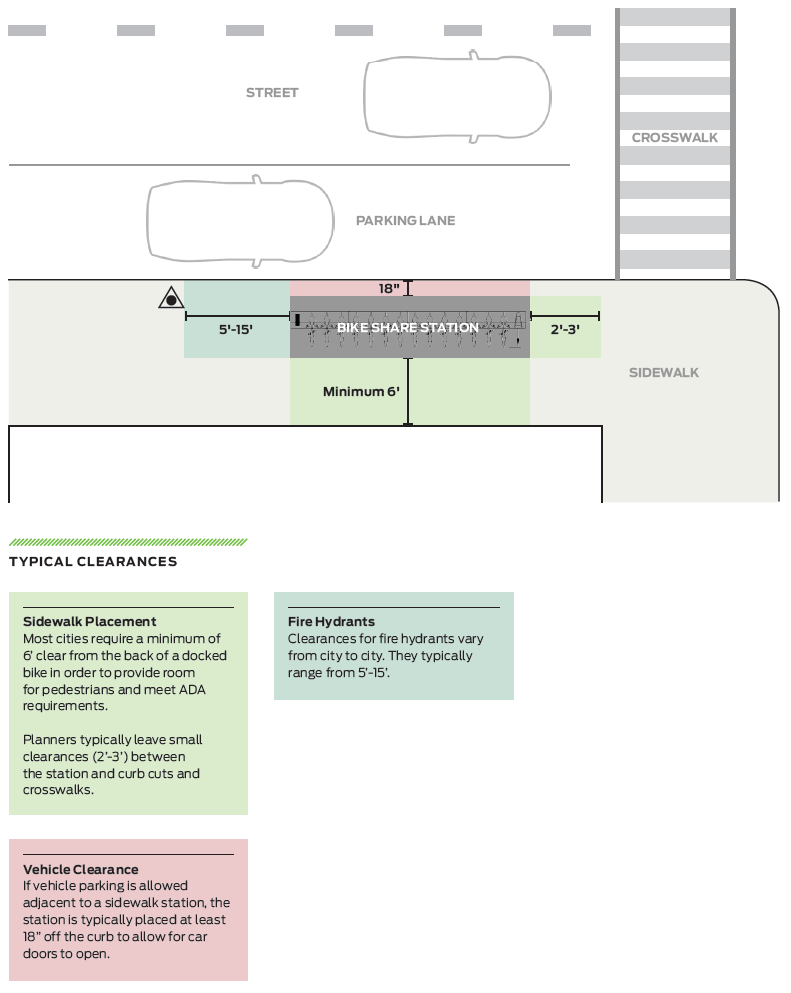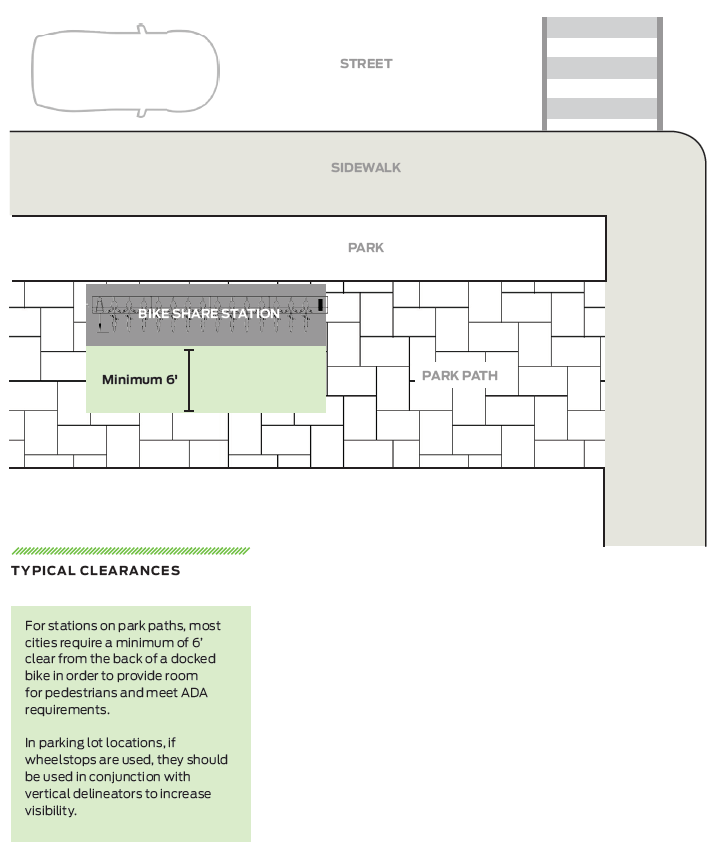Stations in the Street

- On-street bike share stations can be placed anywhere where parked cars would go. Standard station plates (i.e. not angled) can be used in parking lanes that are 8’ wide or greater.
- Most cities allow on-street bike share stations in no parking and no standing zones (“red zones”) when they do not conflict with moving travel lanes or pose other, location-specific issues.
- Because the stations have a lower profile than parked cars, stations do not create sight obstructions. They can be used at intersections to increase pedestrian visibility and safety. Extra care should be used in systems that feature map panels.
- Typically, the payment kiosk should be oriented to face the curb so that users can access the kiosk from the sidewalk.
- On-street stations can create space for other amenities such as private bike parking and seating.
- On-street stations can be key features in larger traffic calming projects and can be placed in medians and floating parking lanes to demarcate and protect pedestrian and cyclist space.
- Wheelstops, stone blocks, flexible delineators, and/or painted buffers are all commonly used to protect on-street stations from moving vehicles. Stone blocks or planters can replace wheelstops on cobble surfaces or other places where wheelstops cannot be installed.
- Station plates should not cover utility access points. However, the bikes can sit on utility points and drainage covers. Bridging and blank plates can create gaps to provide pedestrian access, accommodate loading or avoid obstructions and utilities (see Materials and Design Elements).
- When using angled station plates, the station should be angled so that riders back the bike out into the travel lane and are facing in the direction of traffic (similar to front-in-angle-parking for cars).

Site Drawings: Stations in the Street
Stations on the Sidewalk

- Sidewalk stations should not impede pedestrian flow. Keeping stations in the same line as street furniture and other sidewalk features may help to maintain a pedestrian clear path.
- The payment kiosk should be oriented so that users can access the kiosk while standing on the sidewalk.
- Planners may want to consider adding other amenities such as private bike parking and seating into sidewalk station plans.
- Station plates should not cover utility access points, but the bikes can sit on utility points and drainage covers. Bridging and blank plates can create gaps to provide pedestrian access, accommodate loading, or avoid obstructions and utilities (see Materials and Design Elements).
- Other streetscape features, such as traditional bike racks, can be moved to accommodate bike share stations. However, bike racks should always be relocated nearby, rather than eliminated, so that they will continue to serve the location.

Site Drawings: Stations on the Sidewalk
Stations in Open Space

- Stations should not impede pedestrian flow. Keeping stations in the same line as street furniture and other raised amenities may help to maintain a pedestrian clear path.
- When selecting locations within parks, avoid locations that are isolated, especially in off-peak hours. Special attention should be paid to park uses and pedestrian volumes to ensure that stations will be used and useable at all times.
- Attention should be paid to existing pedestrian desire lines. Stations should not impede pedestrian flow.
- In most cases, plaza stations should also be marked by flexible delineators, planters, blocks, or other street treatments (see Street Treatment Options).
- Bike share station plazas can be built into traffic calming projects and can be used to separate pedestrian space from moving traffic.
- Station plates should not cover utility access points, but the bikes can sit on utility points and drainage covers. Bridging and blank plates can create gaps to provide pedestrian access, accommodate loading, or avoid obstructions and utilities (see Materials and Design Elements).
- Designers should pay additional attention to ensuring that stations are accessible by operations vehicles (rebalancing and maintenance), especially in parks or places with unpaved paths and free flowing pedestrian activity.

Site Drawings: Stations in Open Space
Download the Bike Share Station Siting Guide
Index
Introduction
Materials and Design Elements
Site Drawings